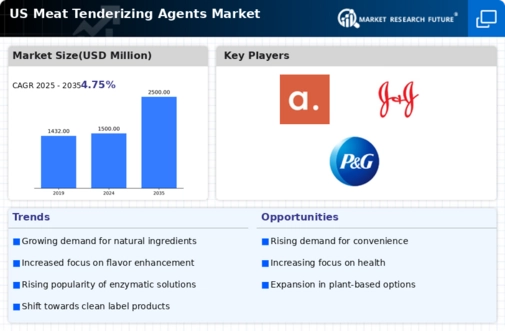Rising Demand for Tender Cuts
The increasing consumer preference for tender cuts of meat is a primary driver in the meat tenderizing-agents market. As culinary trends evolve, consumers are gravitating towards high-quality, tender meat products. This shift is reflected in market data, indicating that the demand for premium meat cuts has surged by approximately 15% over the past year. Consequently, meat processors are increasingly utilizing tenderizing agents to enhance the texture and palatability of their products. The meat tenderizing-agents market is thus experiencing growth as manufacturers seek to meet consumer expectations for tenderness and flavor, leading to a more competitive landscape. This trend is likely to continue as consumers become more discerning about their meat choices, further propelling the demand for effective tenderizing solutions.
Consumer Education and Awareness
Consumer education and awareness regarding meat preparation techniques are emerging as significant drivers in the meat tenderizing-agents market. As consumers become more informed about the benefits of using tenderizing agents, there is a noticeable increase in their adoption in home cooking. Educational campaigns and cooking shows have contributed to this awareness, leading to a projected growth of 8% in the retail segment of the meat tenderizing-agents market. This trend indicates that as consumers learn about the advantages of tenderizing agents, they are more likely to seek out these products for their culinary needs. Consequently, manufacturers are encouraged to invest in marketing strategies that highlight the benefits of their tenderizing agents, further stimulating market growth.
Expansion of Food Service Sector
The expansion of the food service sector in the United States significantly influences the meat tenderizing-agents market. With the rise of restaurants, catering services, and food trucks, there is a growing need for consistent quality in meat preparation. The food service industry has seen a growth rate of around 10% annually, which correlates with an increased demand for meat tenderizing agents to ensure that dishes meet customer expectations for tenderness. As chefs and food service operators strive to deliver high-quality meals, the use of tenderizing agents becomes essential. This trend indicates a robust opportunity for suppliers within the meat tenderizing-agents market, as they can cater to the specific needs of food service providers looking to enhance their meat offerings.
Health Consciousness Among Consumers
The rising health consciousness among consumers is reshaping the meat tenderizing-agents market. As individuals become more aware of their dietary choices, there is a growing demand for healthier meat options. This trend has led to an increased interest in natural and organic tenderizing agents, which are perceived as healthier alternatives. Market Research Future suggests that the organic segment of the meat tenderizing-agents market is expected to grow by approximately 20% in the coming years. This shift towards health-oriented products compels manufacturers to innovate and develop tenderizing agents that align with consumer preferences for clean labels and natural ingredients. Consequently, the meat tenderizing-agents market is likely to adapt to these changing consumer demands, fostering a more health-conscious product range.
Innovation in Meat Processing Technologies
Innovation in meat processing technologies is a crucial driver for the meat tenderizing-agents market. Advances in processing techniques, such as enzymatic tenderization and mechanical methods, have enhanced the effectiveness of tenderizing agents. These innovations not only improve the quality of meat but also increase production efficiency. The meat tenderizing-agents market is witnessing a shift towards more sophisticated processing methods, which are expected to grow by 12% annually. As processors adopt these technologies, the demand for specialized tenderizing agents that complement these methods is likely to rise. This trend suggests a dynamic interplay between technological advancements and the meat tenderizing-agents market, where innovation drives product development and market growth.














Leave a Comment